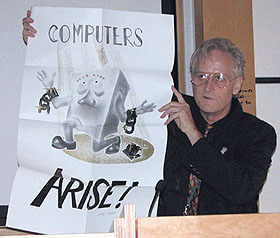2010.08.24: During the first day of the Introduction to Computer Science class, I asked the 26 students the following question: How many of you use Twitter?
My question prompted some gentle giggling, but a couple of hands were raised.
I shared with the class about how I’ve been trying to turn students on to Twitter, but that my current grade would be an F-.
I shared with the class that for me the power of Twitter was in whom I followed. I told the class that the first thing I do when I log into my computer is scan my un-read tweets. I pointed out that if the “right” people are followed, then Twitter can be a treasure trove of great stuff.
Student (sitting in row one): Give us an example.
Me (excited): Did I pay you to say that?
The following example was then presented…
On 2010.08.20 at 6:14am @compufoo tweeted:
RT @hrheingold Doug Engelbart & Ted Nelson came to dinner (14 min vid): http://bit.ly/cprNC8
Student (excited): Doug Engelbart?
Me (yet more excited): Yes. Do know about Doug Engelbart?
Student: Yes, he invented the computer mouse.
Me: How do you know that?
Student: I learned it last semester from Peter Martin. Engelbart was his idol.
Back to the tweet…
RT @hrheingold Doug Engelbart & Ted Nelson came to dinner (14 min vid): http://bit.ly/cprNC8
I explain how my tweet was a re-tweet (RT) of a tweet by @hrheingold (i.e. I follow Howard Heingold on Twitter). Howard Heingold lives in Silicon Valley and he’s a visiting lecturer at Stanford and UC-Berkeley; a research fellow at the Institute for the Future; and a guru when it comes to understanding “virtual communities” (and these days “social networking”). Howard Heingold tweets; he is a user of Twitter. In his Twitter biography, Howard says he’s an “online instigator, educator, offline gardener.”
I click on @hrheingold and we see (which at that time was) Heingold’s most recent tweet.
Thank you! @jimmy_wales for great interview on collaboration. Will publish video eventually.
Wow! Look at that… It appears as though Howard Heingold has interviewed Jimmy Wales and he’s going to share the interview with the world. Question to the class: Who is Jimmy Wales? There’s a pause, so I tell the class that if they use the Wikipedia, then they should give thanks to Jimmy Wales. I also point out to the class that they too can follow @jimmy_wales on Twitter.
Back to the tweet…
RT @hrheingold Doug Engelbart & Ted Nelson came to dinner (14 min vid): http://bit.ly/cprNC8
I point out the class that the power of Twitter is significantly amplified by the ability to insert hyperlinks into tweets. Hyperlinks make the web the World Wide Web (WWW) that it is. But well before the WWW (almost 30 years before), one technologist was thinking about hypertext. Question to the class: Whom do think this technologist was?
“It felt like having Newton and Galileo over for dinner,” wrote Howard Heingold on having dinner with Engelbart and Nelson.
At this point, this power of Twitter example is over. With one tweet I was able to introduce Ted Nelson and Doug Engelbart to the students in an introductory Computer Science class. In addition, the students were introduced to Howard Heingold and Jimmy Wales.
Doh! It turns out this power of Twitter example isn’t over. On 2010.08.26 (i.e. day two) of class, the following was presented.
Let’s rewind three weeks to a tweet by Mitch Kapor.
2010.08.03 at 2:10pm @mkapor tweeted:
I’m grouchy that so few people (except us old-timers) have even heard of Ted Nelson http://bit.ly/cGbsWC (Wikipedia bio)
Observe… Mitch Kapor hyperlinked into the Wikipedia.
2010:08.03 at 2:11pm @mkapor tweeted:
All of the web is in essence a pale shadow of just one of Ted Nelson’s dreams. Now do I have your attention?
2010.08.03 at 2:15pm @nanofoo in reply to @mkapor:
I’m going to make sure my CS1 students learn a bit about Ted Nelson this fall. They’ll come in knowing Gates & Jobs, but not Nelson.
@nanofoo never got reply from @mkapor, but @rossk did…
2010.08.03 at 2:48pm @rossk in reply to @mkapor:
where should the Nelson-newbie start?
2010.08.03 at 8:07pm@mkapor in reply to @rossk
Read “Computer Lib” by Nelson. Also see the Wired article on him for a dissenting view
Mitch Kapor did not provide his followers with hyperlinks, but here they are…
Computer Lib/Dream Machine (dot-pdf) and Wired.com: The Curse of Xanadu

Ted Nelson
Hmm… Who is Mitch Kapor and more…



 Posted by yottagoo
Posted by yottagoo 